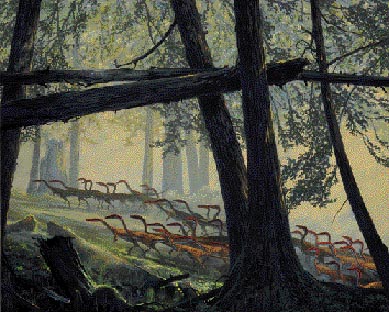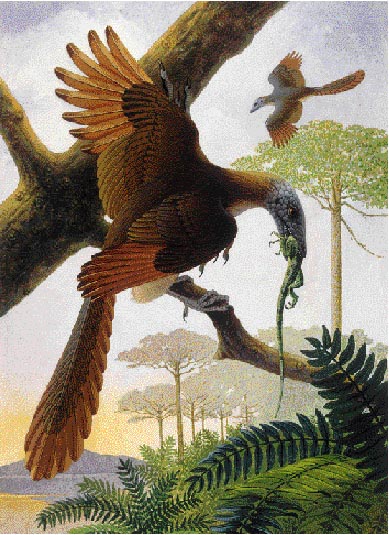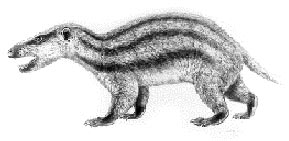 The Age of Dinosaurs
Lives On
The Age of Dinosaurs
Lives OnDinosaurs—we've had a fascination with them for
more than a century. Even before Andrew Carnegie mounted in his Pittsburgh
museum the longest fossil dinosaur skeleton, the world has been hooked
on these exotic creatures. Scientists, Hollywood and our own imaginations
have provided us with many reasons to love dinosaurs: They're huge. They're
scary. They represent a time lost to history, when the Earth was vastly
different from what we see around us today. But that's not the whole story.
Through their study of prehistoric life forms, paleontologists point to
even more reasons to be interested in dinosaurs and the era in which they
lived. Surprisingly, some of this information contradicts what we took
for granted about dinosaurs and the Mesozoic era.
Diversity did not reach full flower until the continents began to separate. For two populations to become progressively distinct they must be prevented from exchanging genes, and scientists agree that geographical barriers such as oceans, mountains and river are key to diversification, even speciation, of all life forms.
"Say you have one species of monkeys living in the Amazon basin," explains Carnegie paleontologist Christopher Beard, "and the river changes course due to a flood. It's now a large barrier—difficult for the monkeys to cross. Through time, those on one side, because of genetic isolation, can become a different species than the monkeys on the other side." This would not happen overnight, of course, but after one or two million years the two species would no longer be able to interbreed. The differentiation of populations due to a geographic barrier is known as "vicariance," from the Latin vicarious for "substitute" or "change."
On a larger scale, when Pangaea began breaking up as the Triassic gave way to the Jurassic some 195 million years ago, the world's oceans became barriers that restricted life forms to their own continents, thus limiting gene flow. This isolation, in turn, stimulated speciation and led to the immense variety of life that inhabits the Earth today.
"Talk about vicariance," Beard continues, "the Earth has never seen
more important splitting of land masses than what happened during the age
of dinosaurs." That age, the Mesozoic, which extended from the Triassic
through the Cretaceous, saw progressive fragmentation of Pangaea, first
into two continents, Laurasia (North America, Europe, Asia) and Gondwana
(South America, Africa, Australia, Antarctica and the Indian subcontinent),
and then into the seven that we have today. But it turns out that all seven
were not entirely separate from each other.
"It was wide-open territory," Beard says of their invasion of North America. "There were no good competitors in North America doing what ceratopsians did well, so they got in and took over." But ceratopsians were by no means the only group of animals to come here from Asia. The fossil record indicates that the same pattern was repeated through time by other dinosaurs as well as by mammals, amphibians and reptiles, all of which flowered once they arrived on this continent, diversifying and overtaking competitors. Closer to home, even an early hominid, Clovis Man, made it across the bridge from Asia to North America a mere 12,000 years ago.
Likewise, the 1995 discoveries by University of Chicago paleontologist Paul Sereno in the Moroccan Sahara indicate dinosaurs' use of another land bridge to travel between northern and southern continents.
Before Sereno's African discoveries, that continent was "essentially an unknown" in terms of dinosaurs, Beard says. But since Africa was a major component of Gondwana, Sereno recognized its potential significance to the comprehensive fossil record. Based on what is known about the continental breakup, Sereno made some predictions about what he might find in Africa, namely, that any dinosaurs he discovered would be related to those of South America, the land mass attached to Africa in the former Gondwana. What he found, however, surprised not only him but the whole paleontological community: One of his finds, Carcharodontosaurus saharicus ("shark-toothed reptile of the Sahara"), is related not only to a South American dinosaur, Giganotosaurus carolinii, found in 1995 in Argentina, but also to Acrocanthosaurus atokensis of North America. What's more, his second Moroccan prize, Deltadromeus agilis ("agile delta runner"), is a relative of T.rex.
These relationships between North American and African dinosaurs indicate
that their ancestors traveled between the northern and southern continents
over a string of islands or a land bridge, such as the extant Straits of
Gibraltar connecting Spain to Northern Africa.
But all dinosaurs were not as large as these popular specimens. Some
of them were downright tiny, relatively speaking. Consider the diminutive
Psittacosaurus, which lived in Asia 113 million years ago and was about
the size of a dog, earning it the nickname "teddy bear of dinosaurs." This
is not to say that Psittacosaurus was an animal you would want to cuddle
up with, however. (But then again, neither is a bear.) An herbivore, it
had a large, sharp beak that it used for biting stems and other hard plant
material, and it had short front legs and was bipedal at most speeds.

Coelophysis was another small dinosaur and is one of North America's
oldest, dating from the late Triassic—around 220 million years ago. The
first known theropod, Coelophysis was only four feet long and had a tail
of the same length. But like Psittacosaurus, this little dinosaur was not
one you would send out into the yard with your kids. A carnivore, it had
the requisite sharp teeth and was voracious, hunting down thecodonts (small
reptiles from which dinosaurs descended) and other primitive prey. Other
dinosaurs were even smaller, like the late Jurassic period's Compsognathus,
which was the size of a chicken.
These small dinosaurs coexisted with the larger varieties we're more familiar with, according to Carnegie paleontologist Mary Dawson, and had to use their speed and cunning to avoid capture by animals further up the food chain.
"Just as today we have life forms large and small, so too did the Mesozoic era contain animals as diverse in size as insects and dinosaurs," she says.
Conversely, some scientists see more of an upward pattern in the sizes of dinosaurs and other animals through the millennia. The aforementioned Psittacosaurus, for instance, was the oldest and most primitive of the ceratopsians. Over millions of years it gave way to the increasingly larger Protoceratops, Triceratops and Torosaurus, whose skull alone was six feet long. This evolutionary pattern of animals evolving upward in size is known as Cope's Rule, proposed in the late 19th century by the prominent Philadelphia paleontologist Edward Drinker Cope. While the rule is disregarded by many scientists, Beard is a believer.
"It's a trend seen all over the animal kingdom," he says. "The earliest known hominid, Lucy, was tiny compared with later hominids and modern humans. The earliest known theropod, Coelophysis, was tiny compared with the latest known theropod, T. rex. Nine times out of 10, evolutionary lineages start small and become large. That's an exciting generalization about the history of life on Earth that many people don't firmly grasp."
Dawson debates the issue, pointing out, "As with many of the late–19th-century
'rules,' straight lines of descent are interesting mainly for the exceptions
to them. Cope's Rule is certainly in this category. It is more interesting
to consider the environmental and evolutionary conditions that may or may
not have led to any trends."
"By all indications, mammals originated about the same time as the earliest dinosaurs—that is, what would be anatomically acceptable as dinosaurs and mammals." In other words, mammals and dinosaurs as we define them appeared around 220 million years ago, but reptilian relatives of both, known as amniotes, go back another 120 million years to the lower Carboniferous era. In fact, all permanently terrestrial vertebrates can trace their common ancestry back to early amniotes, whose distinguishing characteristic was the water-tight egg in which its embryo developed. Some 30 or 40 million years later, the amniote lineage split into synapsids, which evolved into mammals, and diapsids, which led to dinosaurs and birds.
By the time of the late Triassic, the Earth was populated by a variety of life forms, all of which were dominated by the dinosaur. Mesozoic mammals, for instance, were far less abundant and diverse than they are now, and most were insectivores about the size of a mouse. Like today, by the end of the Mesozoic there were egg-laying mammals, or monotremes; pouched mammals, or marsupials; and placental mammals. There were also more primitive mammals including triconodonts, symmetrodonts and multituberculates, all of which are now extinct.

The largest known Mesozoic mammal was Gobiconodon, which weighed 10–12 pounds, measured 18-20 inches and might have resembled a large opossum, but more robust and powerful, and less agile. It was likely more of a walker than a runner and climber, and fossil sites show that it coexisted with several kinds of dinosaurs. Its sharp teeth confirm that it was a predator or scavenger.
Mesozoic birds included several known specimens, among them Archaeopteryx ("ancient wing") lithographica, a winged animal with feathers and a furcula (wishbone), or fused collarbone, which allows for attachment of flight muscles. Were it not for the feathers and a furcula, Archaeopteryx would be considered more a reptilian dinosaur due to its teeth, long tail, fingers at the end of its wings and ribs underneath its body. Also around during the Mesozoic was Deinonychus, a fleet-footed bird-like dinosaur without wings but with undeniably bird-like talons.
"Many behavioral and anatomical features suggest that birds, crocodilians and dinosaurs are closely related, according to Carnegie herpetologist John Wiens. For example, all three have a large hole in the lower jaw that is absent in other vertebrates.
"Most scientists now classify birds, crocodilians (alligators, crocodiles and their relatives), dinosaurs and their extinct relatives into a larger group called the archosaurs," he says. "The fact that crocodilians appear to be closely related to birds shows that the group 'reptiles' is an artificial one. Even though crocodilians are superficially similar to lizards, snakes and turtles, they are actually more closely related to birds."
While the birds we see today did not appear until after the Mesozoic, the fossil record indicates a clear evolutionary progression leading directly back to the theropods—a carnivorous, bipedal group of dinosaurs.
The "birds-from-dinosaurs" theory popular today was first hypothesized in the late 19th century, and compelling evidence leads many scientists to subscribe to it.
"Actually, birds are dinosaurs," says Carnegie ornithologist Bradley Livezey, because they are so directly related to theropods and have striking anatomical similarities. "According to this prevailing view," he continues, "it's safe to say that dinosaurs are not extinct."
Another camp of scientists, including Carnegie ornithologist Kenneth Parkes, puts no stock in the birds-from-dinosaurs theory, claiming that birds evolved separately from some other group of reptiles.
"I've always felt strongly that the evolution of feathers was in connection with the evolution of flight. There was a fuss recently over a fossil of a dinosaur with feathers," says Parkes, referring to Sinosauropteryx, the supposedly feathered theropod that made news in 1996, "but it simply has a ridge down the middle of its back." Parkes believes this ridge is not enough to suggest that Sinosauropteryx was feathered, or that birds descended from dinosaurs.
"Also, the dinosaurs that are considered to be most closely related to Archaeopteryx appeared about 76 million years later than Archaeopteryx," he continues, offering further argument against the birds-from-dinosaurs theory.
Insects have been around through it all, says John Rawlins, invertebrate zoologist at Carnegie Museum of Natural History.
"The earliest known insects were wingless things that looked like silverfish," he says. These primitive insects appeared more than 100 million years before dinosaurs, in the Devonian period (395–345 million years ago).
"Then there was an explosive radiation in the Lower Carboniferous [345–310 million years ago] to produce many of the major insect groups that we have today. By the end of the Permian [on the cusp of the appearance of dinosaurs] you have almost all of the insect orders—all but Lepidoptera, and there is still argument about that one."
So by the time dinosaurs appeared in the Mesozoic, most insects were already well established, and they changed but little, Rawlins says, looking very much like those we see today.
Insects did, however, increase in variety, aided by two major events: The appearance of flowering plants, or angiosperms, at the end of the Cretaceous, provided new foods for insects and thus promoted variety. The appearance of major mountain uplifts fairly recently, in the Pleistocene, provided a geographical barrier to cause speciation.
The entire array of Mesozoic animal life existed in a landscape that
was fairly uniform, says Carnegie botanist Frederick Utech. Since angiosperms
did not appear until late in the Mesozoic, dinosaurs and their contemporaries
were surrounded primarily by ginkos, ferns, evergreen cone-bearing trees
including conifers, such as the Metasequoia (dawn redwood), and cycads.
Today's botanical landscape, while much more varied, contains living examples
of all of these Mesozoic plant groups.
"It really upset the ecological picture," says Mary Dawson of the advent of angiosperms. In addition to their effect on dinosaurs, "angiosperms' more efficient reproductive structures led to their takeover, and many non-angiosperms became extinct." Flowering plants had no adverse effect on mammals, she adds, as most herbivorous mammals had not yet evolved.
Other theories on dinosaur extinction abound. Many scientists subscribe to that of the asteroid impact, which holds that an asteroid crashed into the Gulf of Mexico 65 million years ago, carving out the Chicxulub crater. Hot, flying debris would have rained down upon all parts of the Earth for weeks, and the resulting cloudiness would have altered the climate. According to the theory, these atmospheric conditions eliminated dinosaurs entirely, but spared enough of all other animal groups to bring them into the Cenozoic.
Once dinosaurs were extinct, mammals had a unique opportunity in a world devoid of many terrestrial vertebrates, and over millions of years they moved into a dominant position among these animals. But despite the diversity that blossomed among mammals at that point, there are several modern mammals that have changed very little since their appearance during the age of dinosaurs.
"The opossums of our woods would have been at home in Mesozoic times," Dawson says. "Likewise, the duck billed platypus and echidna, now of the Australian region, would not have been out of place. Even our shrews, small insectivorous mammals, had Mesozoic counterparts."
Even behaviors that we see in some of today's animals were shared by Mesozoic animals, including dinosaurs, scientists say. Nesting, for instance, is a trait that originated with the common ancestor of birds, dinosaurs and crocodilians. Other behaviors that evolved in the Mesozoic or earlier, and are still present in today's animals, include constricting in snakes and singing in birds.
Similarities also exist among contemporary and Mesozoic plants. Ferns, evergreens and ginkos are common plants in the contemporary landscape. Some are native only to particular areas but are transplanted widely, for example the gingko and the Metasequoia conifer, which are native to small regions in China, and the Norfolk Island pine, native only to several south Pacific islands.
While dinosaurs have been extinct for 65 million years, their descendants, and descendants of their contemporaries, are with us today in the plants and animals that we see around us. They are reminders that the Mesozoic world is not as foreign as we might have believed, and that the age of dinosaurs lives on.
Kathryn M. Duda is associate editor of Carnegie Magazine.